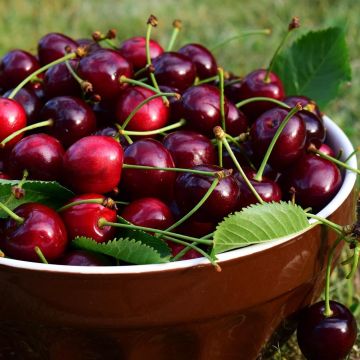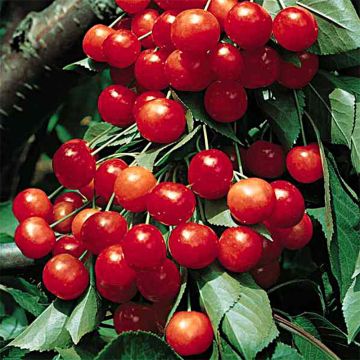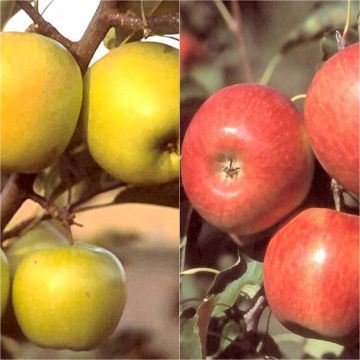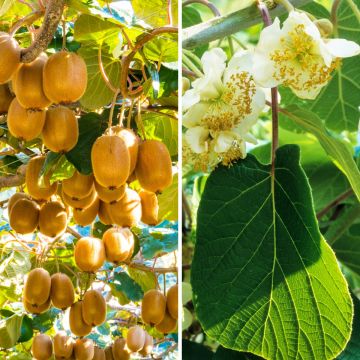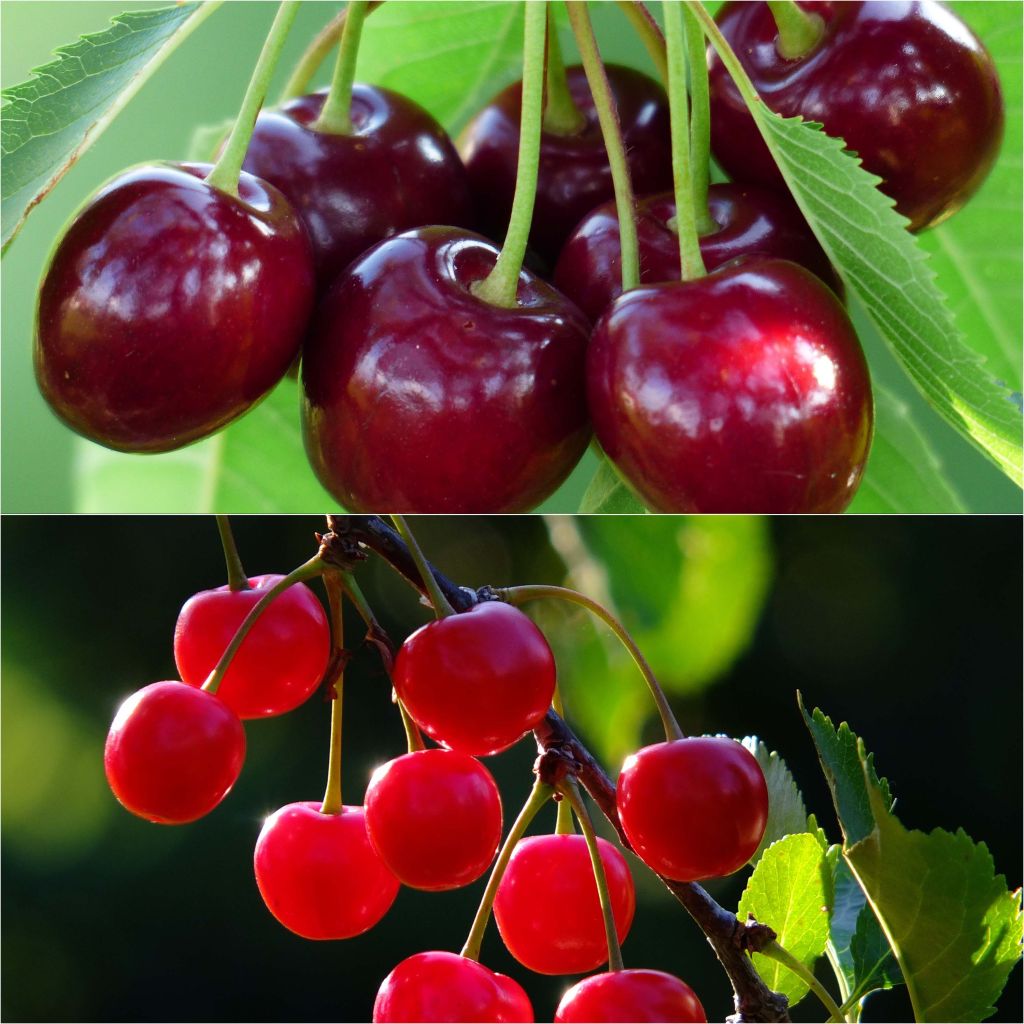

Cherry tree pollinator duo for a tasty harvest
Cherry tree pollinator duo for a tasty harvest
Prunus cerasus Bigarreau Burlat, Bigarreau Coeur de Pigeon
This plant carries a 6 months recovery warranty
More information
We guarantee the quality of our plants for a full growing cycle, and will replace at our expense any plant that fails to recover under normal climatic and planting conditions.
From €5.90 for pickup delivery and €6.90 for home delivery
Express home delivery from €8.90.
Delivery to Corse prohibited: UE law prohibits the import of this plant from mainland France to Corse as part of the fight against Xylella fastidiosa. Please accept our sincere apologies.
More information
Collection items (2 plants)
Description
This pollinator duo of cherry trees for a tasty harvest brings together the varieties 'Burlat Sweetheart' and 'Pigeon Heart', renowned for their excellent table cherries, particularly delicious. Planted in the same garden, within a radius of 20 to 30 meters (66 to 98 feet), these two cherry trees that bloom together between mid-March and mid-April pollinate each other. This ensures a plentiful harvest, which will spread from late May to the end of June.
This duo consists of:
- 1 x 'Burlat Sweetheart' Cherry Tree: an early and productive variety, providing large, sweet fruits with firm and crunchy flesh, excellent taste, and a shiny dark red skin. The tree has good resistance to late frosts. From mid-March, it is covered with small white flowers that appear before the foliage. The Burlat variety is harvested from late May. It is mainly enjoyed as is, "under the tree".
- x1 'Pigeon Heart' Cherry Tree: this old vigorous variety produces large heart-shaped fruits, sweet, with firm and crunchy yellow flesh, slightly acidic, and a shiny light red skin. They are harvested in June. The tree often exceeds 6 meters (20 feet) in height and spread.
The harvest may be more or less abundant depending on the year and present an alternate phenomenon, allowing the tree to replenish its reserves. Fruit production becomes optimal after 6 to 7 years. Enjoy the cherries just after picking or, if the harvest is abundant, make pies, clafoutis, jams, and preserves. Cherries are rich in vitamin C, minerals, and trace elements. Cherries should be picked when ripe as they do not ripen after harvest.
The Cherry Tree, in Latin Prunus avium, belongs to the rose family. It is a medium-sized tree, reaching 5 to 10 meters (16 to 33 feet) in height at maturity. Its rounded habit offers a beautiful shaded space, very pleasant during the summer. Its alternate and toothed leaves are shiny and dark green, then they take on a lovely reddish hue in autumn before falling.
A half-standard fruit tree consists of a branch attached to a trunk, which is only between 1.20 and 1.50 meters (4 and 5 feet) high. The branches will be a little shorter than a standard.
Report an error about the product description
Plant habit
Fruit
Flowering
Foliage
Botanical data
Prunus
cerasus
Bigarreau Burlat, Bigarreau Coeur de Pigeon
Rosaceae
Cultivar or hybrid
Other Cherry trees
Planting and care
The Cherry tree grows in any type of soil, acidic or chalky. It prefers fresh, light soils and fears heavy and clayey soils. Choose a sunny exposure. In order to limit the risks of late frosts on the flowers, it is recommended to plant the Cherry tree in a sheltered location, facing west and protected from cold winds in regions that experience spring frosts. Planting is preferably done in autumn. If you plant several plants, space them 4 to 5 m (13 to 16ft) apart for goblet-shaped plants.
Loosen the soil deeply, remove stones and unwanted weeds. Add some sand to improve drainage. Dig a hole 4 to 5 times the volume of the root ball. Make sure to separate the bottom soil from the surface soil. Mix crushed horn or well-rotted compost or potting soil with the bottom soil and pour this mixture into the planting hole. Install a stake. Place the root ball, cover with the surface soil and firm it down well. Water generously (about 10 L). Attach the stake to the plant, crossing the tie in the shape of an 8, without touching the trunk.
During cultivation, watering is not necessary except in case of high temperatures. Mulch at the base to keep it cool in summer. Protect your harvest by installing, optionally, a bird net, aluminum foil or old CDs. In case of an aphid attack, spray water mixed with black soap.
Planting period
Intended location
Care
This item has not been reviewed yet - be the first to leave a review about it.
Our fruit tree and berry bush collection
Haven't found what you were looking for?
Hardiness is the lowest winter temperature a plant can endure without suffering serious damage or even dying. However, hardiness is affected by location (a sheltered area, such as a patio), protection (winter cover) and soil type (hardiness is improved by well-drained soil).

Photo Sharing Terms & Conditions
In order to encourage gardeners to interact and share their experiences, Promesse de fleurs offers various media enabling content to be uploaded onto its Site - in particular via the ‘Photo sharing’ module.
The User agrees to refrain from:
- Posting any content that is illegal, prejudicial, insulting, racist, inciteful to hatred, revisionist, contrary to public decency, that infringes on privacy or on the privacy rights of third parties, in particular the publicity rights of persons and goods, intellectual property rights, or the right to privacy.
- Submitting content on behalf of a third party;
- Impersonate the identity of a third party and/or publish any personal information about a third party;
In general, the User undertakes to refrain from any unethical behaviour.
All Content (in particular text, comments, files, images, photos, videos, creative works, etc.), which may be subject to property or intellectual property rights, image or other private rights, shall remain the property of the User, subject to the limited rights granted by the terms of the licence granted by Promesse de fleurs as stated below. Users are at liberty to publish or not to publish such Content on the Site, notably via the ‘Photo Sharing’ facility, and accept that this Content shall be made public and freely accessible, notably on the Internet.
Users further acknowledge, undertake to have ,and guarantee that they hold all necessary rights and permissions to publish such material on the Site, in particular with regard to the legislation in force pertaining to any privacy, property, intellectual property, image, or contractual rights, or rights of any other nature. By publishing such Content on the Site, Users acknowledge accepting full liability as publishers of the Content within the meaning of the law, and grant Promesse de fleurs, free of charge, an inclusive, worldwide licence for the said Content for the entire duration of its publication, including all reproduction, representation, up/downloading, displaying, performing, transmission, and storage rights.
Users also grant permission for their name to be linked to the Content and accept that this link may not always be made available.
By engaging in posting material, Users consent to their Content becoming automatically accessible on the Internet, in particular on other sites and/or blogs and/or web pages of the Promesse de fleurs site, including in particular social pages and the Promesse de fleurs catalogue.
Users may secure the removal of entrusted content free of charge by issuing a simple request via our contact form.
The flowering period indicated on our website applies to countries and regions located in USDA zone 8 (France, the United Kingdom, Ireland, the Netherlands, etc.)
It will vary according to where you live:
- In zones 9 to 10 (Italy, Spain, Greece, etc.), flowering will occur about 2 to 4 weeks earlier.
- In zones 6 to 7 (Germany, Poland, Slovenia, and lower mountainous regions), flowering will be delayed by 2 to 3 weeks.
- In zone 5 (Central Europe, Scandinavia), blooming will be delayed by 3 to 5 weeks.
In temperate climates, pruning of spring-flowering shrubs (forsythia, spireas, etc.) should be done just after flowering.
Pruning of summer-flowering shrubs (Indian Lilac, Perovskia, etc.) can be done in winter or spring.
In cold regions as well as with frost-sensitive plants, avoid pruning too early when severe frosts may still occur.
The planting period indicated on our website applies to countries and regions located in USDA zone 8 (France, United Kingdom, Ireland, Netherlands).
It will vary according to where you live:
- In Mediterranean zones (Marseille, Madrid, Milan, etc.), autumn and winter are the best planting periods.
- In continental zones (Strasbourg, Munich, Vienna, etc.), delay planting by 2 to 3 weeks in spring and bring it forward by 2 to 4 weeks in autumn.
- In mountainous regions (the Alps, Pyrenees, Carpathians, etc.), it is best to plant in late spring (May-June) or late summer (August-September).
The harvesting period indicated on our website applies to countries and regions in USDA zone 8 (France, England, Ireland, the Netherlands).
In colder areas (Scandinavia, Poland, Austria...) fruit and vegetable harvests are likely to be delayed by 3-4 weeks.
In warmer areas (Italy, Spain, Greece, etc.), harvesting will probably take place earlier, depending on weather conditions.
The sowing periods indicated on our website apply to countries and regions within USDA Zone 8 (France, UK, Ireland, Netherlands).
In colder areas (Scandinavia, Poland, Austria...), delay any outdoor sowing by 3-4 weeks, or sow under glass.
In warmer climes (Italy, Spain, Greece, etc.), bring outdoor sowing forward by a few weeks.









































